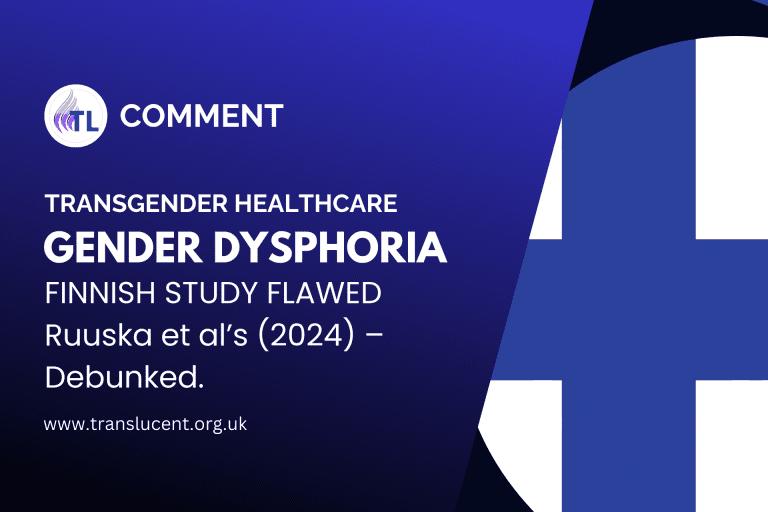An eye-catching conclusion
Ruuska et al’s (2024) paper in BMJ Mental Health compares two groups of young people in Finland.1 The ‘gender dysphoria’ (GD) group comprises more than 2,000 people under 23 who had been referred to one or other of the country’s gender identity clinics. An even larger ‘control group’ (matched to the GD group in terms of age and birthplace) is used to compare the outcomes experienced by the GD group with those seen in the general population.
The outcome of particular interest to Ruuska et al is suicide, and an initial comparison of the two groups shows some very interesting differences:
- Members of the GD group were three times more likely to commit suicide than was the case among the controls.
- When compared with the controls, members of the GD group were much more likely to have sought specialist mental health care.
I suspect that most people would not find either of these results surprising. One can easily imagine an underlying gender dysphoria, perhaps exacerbated by family and societal hostility, causing the kind of mental distress which leads people to seek out mental health services and, possibly, attempt suicide.
But here’s the surprising thing: once the authors have finished analysing this data, they conclude that GD is not the reason for that increased rate of suicide. Instead, they suggest, when the need to use mental health services is “accounted for”, the difference in suicide risk between the GD and control groups essentially disappears, leaving behind mental illness as the “main predictor” of suicide.
Why is this important? Well, the paper’s message is essentially that the presence or absence of GD is not important in determining someone’s risk of suicide, but the presence of some co-existing mental illness is. If those responsible for designing specialist gender care services were to accept this conclusion, they might end up deciding that services should shift their attention from the provision of gender affirming care, and instead focus on treating the associated mental illness. TransLucent believes this would be a big step backwards.
An assumption spelt out
Now the sort of analysis (multivariate regression modelling) Ruuska et al have used to arrive at their conclusion is very widely used and can often be the appropriate way to sort out which variables are important.
But the details of when and how this technique is used can be critical. And in this paper, there is at least one critical piece out of place: the authors treat the use of specialist mental health care as what statisticians call a ‘confounder’.
Confounders can lead us up the garden path. For example, we might conclude that eating a lot of ice cream cones gives you skin cancer. Not true. Ice cream cone consumption is ‘confounded’ with exposure to sunshine, because sunshine causes both ice cream consumption and skin cancer. If we account for this in our analysis, we can identify the sun as the real culprit and let Mr. Whippy off the hook.
Part of the reason that we can do this relatively easily is that the causal relationship between sunshine and ice cream is clear. People eat more ice cream because it is sunny, but ice cream does not have a causal role as far as the sun is concerned: eating ice cream does not make the sun come out.
The presence of this sort of simple one-way relationship is something which statisticians require before something can be considered as a confounder.2
Does the Finnish analysis of gender dysphoria comply with this statistical rule? For us to say yes, we would need to believe something that seems very unlikely to be true. We would need to believe that gender dysphoria has no role in causing people to seek mental health care. I don’t believe that. Do you?
Do Ruuska et al? Well, they certainly have some doubts – they admit, in rather oblique terms, that mental illness might be part of a “…pathway linking GD to mortality”. By this they mean that GD might cause the sort of mental illness that can lead to suicide. Well, Sherlock, I’m not sure I have a polite reaction to that obvious truth.
The big problem is that Ruuska et al go ahead and treat mental health care as a confounder anyway. They use it to adjust their results to take away the apparent (and entirely plausible) role of GD in a sequence of events that ends in suicide. Instead of properly accounting for the effects of psychiatric illness, the authors appear to be guilty of something statisticians call ‘overadjustment’.3 The likely upshot is that they have wrongly obscured GD’s role in causing suicides.
Enter the Health Nerd
I’ve tried to highlight one serious problem with the statistics used in this paper – but other (more expert) eyes have detected multiple issues which, taken together, thoroughly undermine the big claims it makes in its conclusions.
Check out what epidemiologist Gideon Meyerowitz-Katz AKA Health Nerd writes in a detailed and compelling critique of the stats in this paper.4
He tackles the authors’ failure to properly consider cause and effect – the issue I have focused on – and frankly does so in more insightful terms than I am capable of. But he also takes on the paper’s second big-ticket conclusion – that gender affirming care “…does not have an impact on suicide risk”.
I will leave you to read his thoughtful analysis of the bizarre statistical process that gets the authors to this conclusion – but I will relay his summary of what this paper actually shows about the value of providing gender affirming care to gender dysphoric people.
It comes in two equally important parts:
- In this study, the provision of hormones and surgery appears to be associated with a very large reduction in the risk of suicide among young people with gender dysphoria.
- From the data we have available, we cannot be certain about this extent of this benefit.
The reasons for this uncertainty lie in a couple of aspects of this paper. Firstly, Ruuska et al omit some crucial numbers from it. This omission means that Health Nerd has to estimate the reduction in suicide risk from the limited data they do publish. He reckons the reduction is about 70%, but freely admits that he can’t be exact.
The second reason lies in the good news that, even in this very large study, there were only seven suicides in the whole of the GD group. When you are trying to establish the factors that explain rare events, that very rarity makes things difficult, even for highly competent statisticians. The trick is to learn what you can from the numbers, while constantly avoiding the urge to over-interpret them.
Factor X
For an academic paper, Ruuska et al’s study has gained a huge amount of attention, particularly among X users. Less than a month after publication, there have been over 3,200 tweets publicising the work.
The general flavour of around 95% of this twittering is: this study has delivered the answer – GD does not lead to suicide and there is no point in treating GD, because doing so does not reduce the risk of suicide.
Having read this paper very carefully, I disagree. I believe that it provides evidence for some very different conclusions:
- GD does underlie an increased risk of suicide, probably mediated (at least in part) by mental illness; and
- Treating GD is beneficial for reasons including the potential for that treatment to help stop young people with GD taking their own lives.
Now, although Ruuska et al’s figures do not conclusively demonstrate my views to be correct, my real problem is that 3,000 people on X are behaving as if the authors’ flawed and overstretched study is conclusive about anything. And it really isn’t. The authors needed to take more care in their analysis and deduction, and the audience needs to take more care in deciding what it believes.
More healthcare needed
However, there are probably some things on which we can all agree: mental ill-health appears to be prevalent among those who experience GD; it should be diagnosed and treated; doing so will probably contribute to reducing the risk of suicide among those with GD. This is the note on which Ruuska et al end their paper – and it gets a thumbs up from TransLucent.
However, any suggestion that health services should switch their attention away from gender dysphoria and just concentrate on the psychiatric needs of those presenting with GD surely can’t be right.
The relationship between GD and co-existing mental illness is likely to be complex and variable. We’ll need to see that all the care needs of gender dysphoric young people are attended to.
Influencer
While the authors of this paper are responsible for its flaws, they perhaps can’t be held primarily responsible for the knuckle-headed way in which its conclusions have been relayed via social media.
Fortunately, the senior author on the paper, Professor Riittakerttu Kaltiala, is in a position to help correct the record. The competing interests section of the paper reveals that she is a member of the advisory board of The Cass Review, which will be making recommendations to the NHS about the design of services for young people presenting with gender dysphoria.5 It will be important for the Review to gain a nuanced appreciation of the relevant research, including this paper.
She is also the keynote speaker at the upcoming conference of the Clinical Advisory Network on Sex and Gender (CAN-SG). While the name of this organisation might suggest it aims to facilitate a clinical consensus in an area characterised by uncertainty and division, the advance publicity for the conference suggests its approach is relentlessly hostile to gender affirming care.
Professor Kaltiala is on record as saying that medicine “… is not immune to dangerous groupthink that results in patient harm”.6 TransLucent hopes that she will use her CAN-SG platform to relay the results of her research with the caveats and humility that constitute the best defence when the threat of groupthink looms.
References
1 Sami-Matti Ruuska and others, ‘All-Cause and Suicide Mortalities among Adolescents and Young Adults Who Contacted Specialised Gender Identity Services in Finland in 1996–2019: A Register Study’, BMJ Ment Health, 27.1 (2024) <https://doi.org/10.1136/bmjment-2023-300940>.
2 K. J. Jager and others, ‘Confounding: What It Is and How to Deal with It’, Kidney International, 73.3 (2008), 256–60 <https://doi.org/10.1038/sj.ki.5002650>.
4 Health Nerd, ‘Does Gender Affirming Care Reduce Suicide Rates For Young People With Gender Dysphoria?’, Gideon M-K: Health Nerd, 2024 <https://gidmk.substack.com/p/does-gender-affirming-care-reduce> [accessed 28 February 2024].
5 ‘Cass Review – Independent Review of Gender Identity Services for Children and Young People’ <https://cass.independent-review.uk/> [accessed 10 March 2024].
6 ‘“Gender-Affirming Care Is Dangerous. I Know Because I Helped Pioneer It.”’, The Free Press, 2023 <https://www.thefp.com/p/gender-affirming-care-dangerous-finland-doctor> [accessed 28 February 2024].










 To provide the best experiences, we use technologies like cookies to store and/or access device information. Consenting to these technologies will allow us to process data such as browsing behaviour or unique IDs on this site. Not consenting or withdrawing consent, may adversely affect certain features and functions.
To provide the best experiences, we use technologies like cookies to store and/or access device information. Consenting to these technologies will allow us to process data such as browsing behaviour or unique IDs on this site. Not consenting or withdrawing consent, may adversely affect certain features and functions.